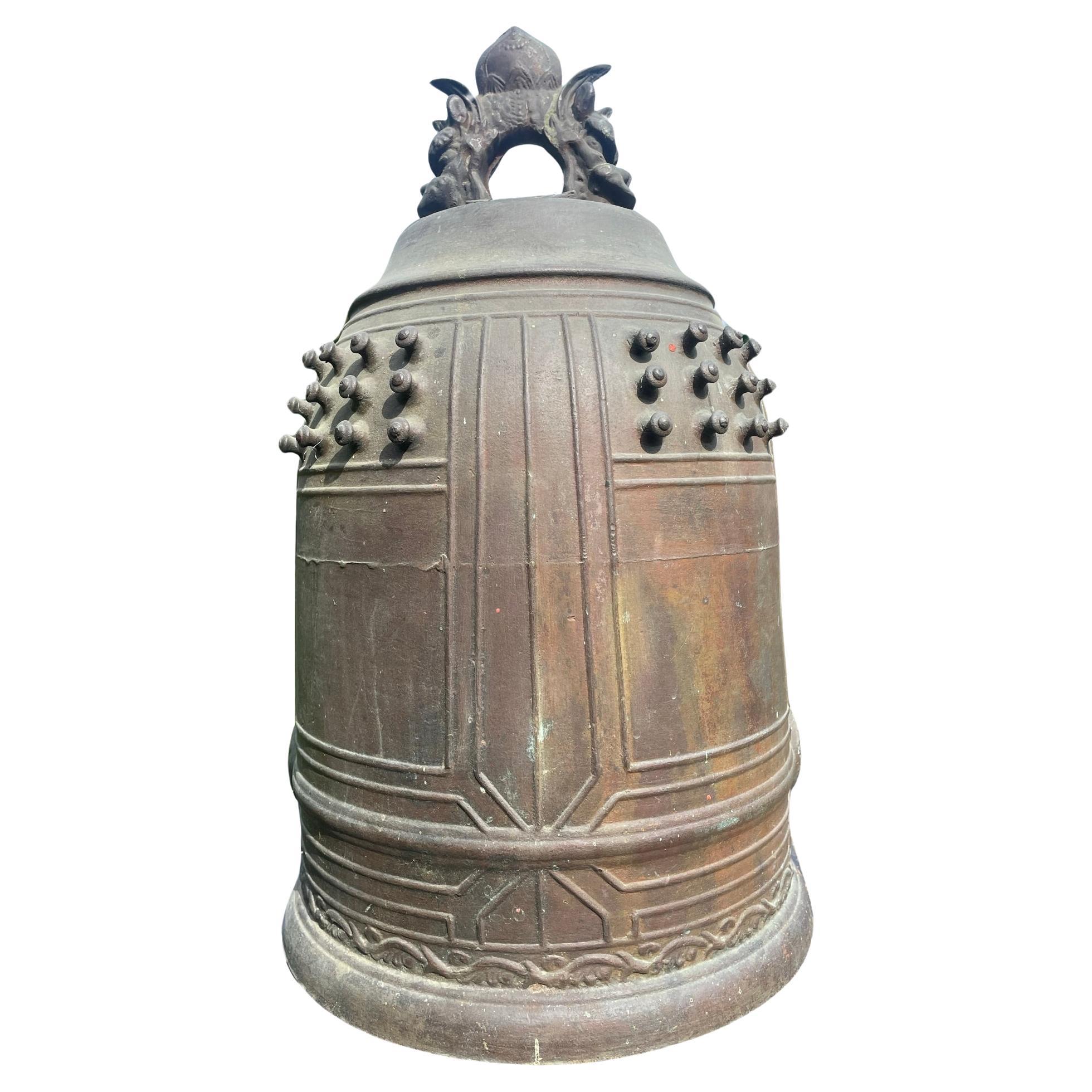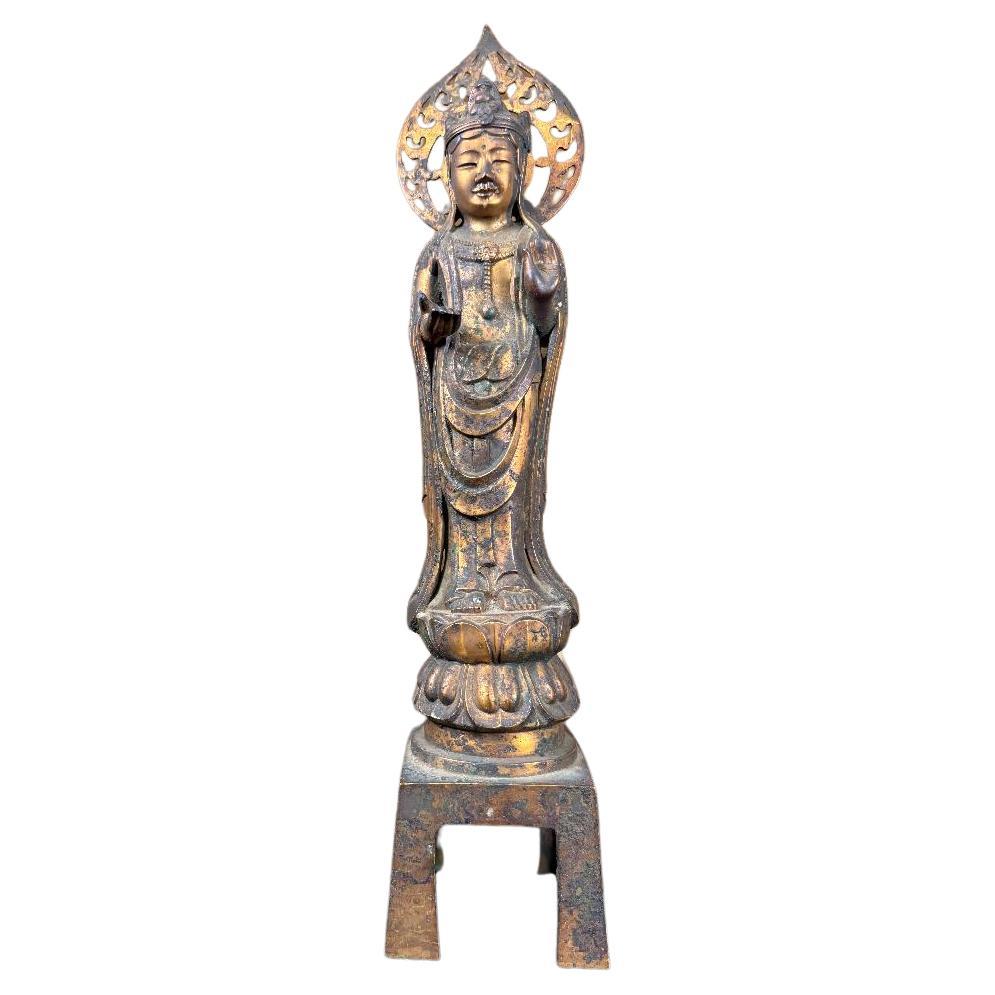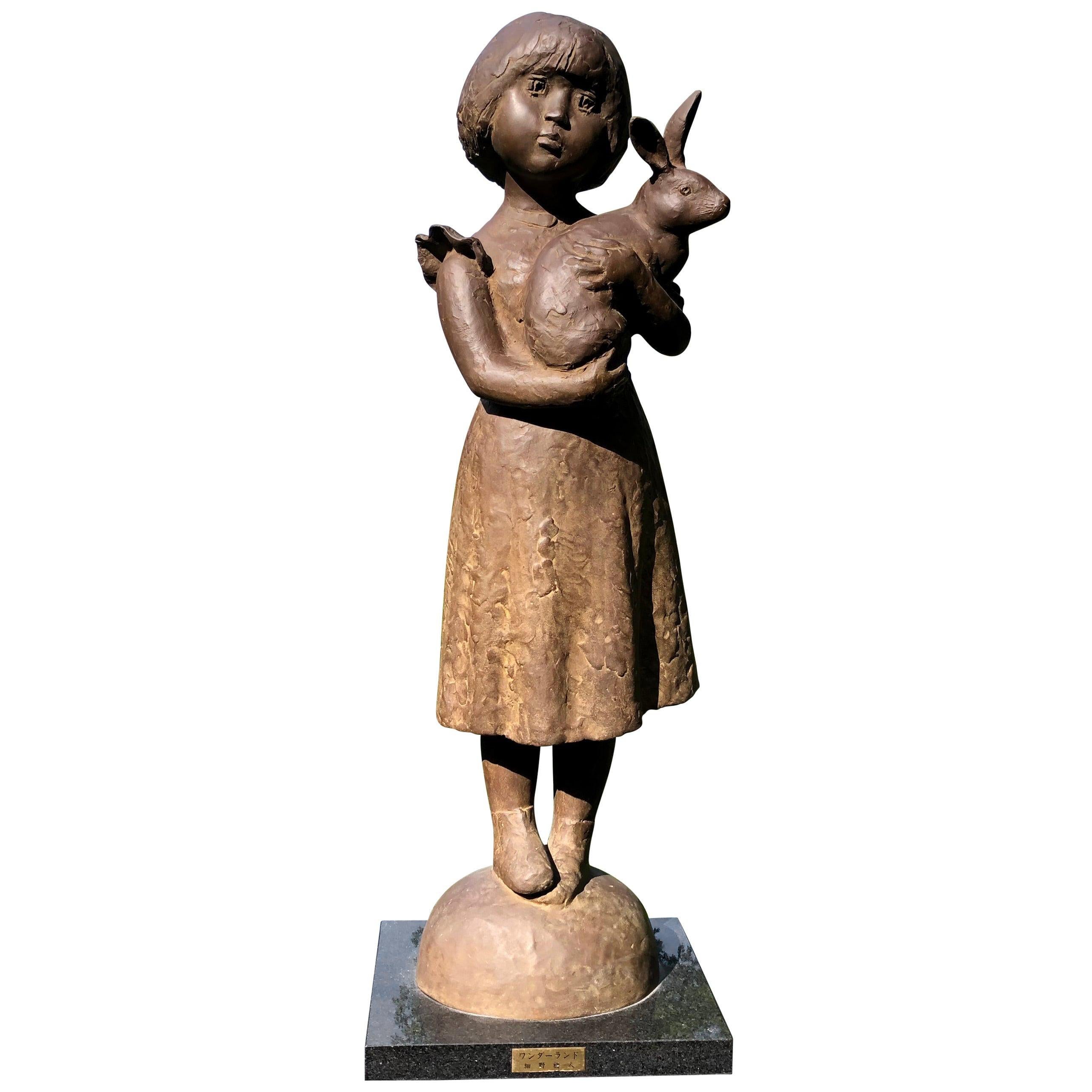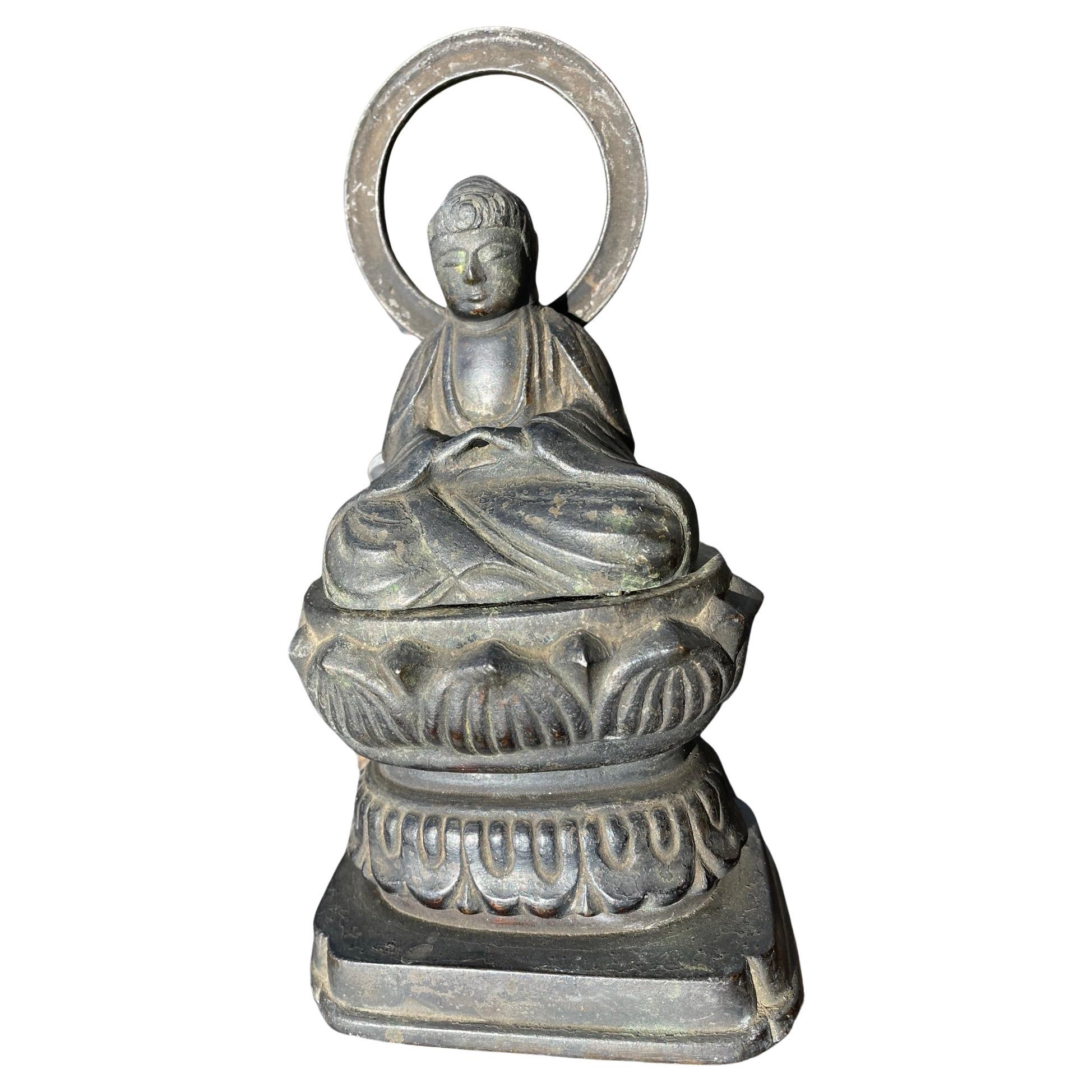Items Similar to Japanese Vintage Tea Ceremony Bronze Tea Bell
Want more images or videos?
Request additional images or videos from the seller
1 of 12
Japanese Vintage Tea Ceremony Bronze Tea Bell
About the Item
A one-of-a-kind rare tea ceremony accessory discovered from our recent Japanese acquisitions travels.
Seldom seen and with lovely sound.
This is an extraordinary opportunity to collect and acquire a scarce Japanese hand cast bronze "Tea Ceremony" hand bell featuring human face and scroll designs front and back of the handle top. It is complete with a charming scroll top handle design. The handle comfortably acommodates ones hand and the whole sits on four feet for attractive display. It may have been rung to alert people sitting in the garden that the tea ceremony was about to begin.
The bell contains pellets that emit a pleasant alerting sound when gently shaken.
It boasts an original rich and warm colored dark chocolate brown patina appropriate to its good age.
Dates to the early 20th century
Dimensions: 7.5 inches tall
Lifetime guarantee of authenticity: All of our Asian works of art come with our lifetime authenticity guarantee.
- Dimensions:Height: 7.5 in (19.05 cm)Width: 3 in (7.62 cm)Depth: 2 in (5.08 cm)
- Style:Taisho (Of the Period)
- Materials and Techniques:Bronze,Cast
- Place of Origin:
- Period:
- Date of Manufacture:Early 20th Century
- Condition:Wear consistent with age and use.
- Seller Location:South Burlington, VT
- Reference Number:1stDibs: LU1289224814322
About the Seller
5.0
Gold Seller
These expertly vetted sellers are highly rated and consistently exceed customer expectations.
Established in 1990
1stDibs seller since 2015
2,214 sales on 1stDibs
Typical response time: 1 hour
- ShippingRetrieving quote...Ships From: South Burlington, VT
- Return PolicyA return for this item may be initiated within 7 days of delivery.
More From This SellerView All
- Japanese Large Old Signed Bronze Temple Bell with Bold Sound, 19 InchesLocated in South Burlington, VTFor your special garden setting or indoor display space. Large Hand Cast Original Green Patina Bronze Bell With Makers Signature emblazoned on its side. Bold pleasing sound Beautiful deep resonating ring tones await the new owner of this large one-of-a-kind antique bronze bell from old Japan. Its beautiful light green patina makes it an attractive and desirable work of art. This distinctive dragon headed bell called ryuzu and remarkable protrusions called chi chi or nyu are crafted by generations old skilled Japanese specialists to improve sound resonance and are unique to Japan's ancient traditions. This antique hand cast bronze temple bell dates to the middle Showa period, mid last century. Signed with the makers name please see photographs. A rare survivor, this rugged bell was gently used. Please note its impressive cast dragon headed top ryuzu, thick walls and original blue gray toned patina. Dimensions: 19 inches tall and 11 inches diameter. It has been used and possesses an original light green aged patina appropriate to its age-just the way we like to find them. Its deep resonating sound is guaranteed to please you. In addition. It’s bold sound of brings to the Japanese people - the “voice of Buddha” is even more impressive because of its thick walls (see photo). This bell sound and voice of Buddha was used to deliver wishes to the temples patrons and followers. We will also include a complimentary hand striker. Unique. Great garden consideration. Only One. Lifetime guarantee of authenticity. History of Japan's temple bells, bonsho : Rather than containing a clapper, bonsho is struck from the outside, using either a handheld mallet or a beam suspended on ropes. Antique Japanese bronze temple bells...Category
Antique Late 19th Century Japanese Showa Sculptures and Carvings
MaterialsBronze
- Japan Fine Antique Bronze Kanon Guanyin Signed Shohei, Beautiful FaceLocated in South Burlington, VTJapan, a fine and elegant antique Kanon Guan Yin standing in a classic compassionate mudra- a superb work of art cast in solid bronze with original traces of old gold gilding. Signe...Category
Early 20th Century Japanese Taisho Paintings and Screens
MaterialsBronze
- Japanese Bronze a Woman with Dove Midcentury SculptorLocated in South Burlington, VTJapan a lovely, sensitive cast bronze sculpture of a woman gently holding a dove in her hands. The naive female nude by a midcentury sculptor. This is a Classic midcentury nude f...Category
20th Century Japanese Mid-Century Modern Sculptures and Carvings
MaterialsBronze
- Japanese Important Bronze Lady With A Newport HatLocated in South Burlington, VTJapan a lovely, sensitive cast bronze sculpture of a woman proudly showing her Newport Hat. Designed and cast by by noted Japanese mid century sculptor Tabath Isao. This is a cla...Category
20th Century Japanese Mid-Century Modern Paintings and Screens
MaterialsBronze
- Japanese Important Tall Bronze Rabbit Girl Of WonderlandLocated in South Burlington, VT"Rabbit Girl of Wonderland" Japan, an important tall 35" hand cast bronze effigy of a young woman clutching a prize rabbit, by important national artisan ...Category
20th Century Japanese Mid-Century Modern Sculptures and Carvings
MaterialsBronze
- Japan Fine Bronze Seated Amidha Nyorai Buddha, 19thc.Located in South Burlington, VTJapan, an elegant and fine seated Amidha Nyorai Buddha with fingers clasped in a pensive "Dhyani" Mudra pose, a superb work of art cast in bronze. It dates to the 19th century Meiji...Category
Antique 19th Century Japanese Meiji Paintings and Screens
MaterialsBronze, Copper
You May Also Like
- Japanese 2-Panel Furosaki’byôbu 風炉先屏風 'Tea-Ceremony Folding Screen' with DragonsLocated in Amsterdam, NLA striking low and wide two-panel furosaki’byôbu (tea-ceremony room divider) painted with two bright white dragons (ryû) flying amidst swirling black clouds. The left dragon holds a ...Category
Early 20th Century Japanese Paintings and Screens
MaterialsWood, Paper
- Antique Double Sided Japanese Ranma Transom Panels - a PairLocated in Morristown, NJ19th/20th c., Antique hand-carved Japanese ramna panels depicting landscapes of black pine trees, temples, mountains and clouds. Likely carved from yaku cedar in the Osaka tradition of chokokuranma (carved transom), these are double sided three-dimensional landscape designs. The design is mirrored on each side of the panel. Ranma panels...Category
Antique Late 19th Century Japanese Meiji Paintings and Screens
MaterialsWood, Cedar
- Japanese Gilt Wood Panel Deer at the Base of Mount FujiLocated in Douglas Manor, NY1262 Japanese gilt wood panel deer at the base of mount Fuji.Category
Vintage 1940s Sculptures and Carvings
MaterialsFruitwood
- Japanese Meiji Door Carvings Featuring Owl and Parrot in Mother of Pearl & BonesLocated in New York, NYJapanese Meiji period pair of wooden doors featuring carvings of an owl and a parrot on perch, with birds and flowers. The carvings are executed i...Category
Antique 1890s Japanese Meiji Sculptures and Carvings
MaterialsBone, Mother-of-Pearl, Wood
- Japanese Double-Cut 'Nijū-giri' Flower Container 'Hanaire' Ikebana Tea CeremonyLocated in Ottawa, OntarioJapanese Double-cut (Niju-giri) Flower Container (Hanaire) for ikebana tea ceremony. 1st half of 20th century. Cut from a single piece of bamboo with root section and openings for two tier flower arrangement, Niju-ike, copper cups...Category
Early 20th Century Japanese Japonisme Sculptures and Carvings
MaterialsBamboo
- 19th Century Japanese Screen for Tea-Ceremony, Ink Bamboo and Plum on Gold LeafLocated in Kyoto, JPThree Friends of Winter Nakajima Raisho (1796-1871) Late Edo period, circa 1850 Ink and gold leaf on paper. This is a double-sided Japanese Furosaki or tea-ceremony screen from the mid 19th century; bamboo and plum on the front, young pines the back. It by Nakajima Raisho, a master painter of the Maruyama school in the late Edo and early Meiji periods. In this work Raisho combines exquisite ink brushwork with large open spaces of brilliant gold-leaf to inspire the viewers imagination. Rather than naturalism, he is searching for the phycological impression of the motifs, resulting in abstraction and stylization. His simplification of the motifs the result of looking to capture the inner nature of the objects. This art motif is known as Sho Chiku Bai, or the Three Friends of Winter. Evergreen pine connotes steadfastness, bamboo suggests both strength and flexibility, while plum blossoms unfurling on snow-laden branches imply hardiness. Combined, this trio is emblematic of Japanese new year. Chinese literati were the first to group the three plants together due to their noble characteristics. Like these resilient plants flowering so beautifully in winter, it was expected of the scholar-gentleman to cultivate a strong character with which he would be able to show the same degree of perseverance and steadfastness even during times of adverse conditions. The screen would have been placed near the hearth of a room used for the Japanese tea ceremony, shielding the fire from draughts and also forming a stimulating and decorative backdrop behind the tea utensils. It would have been used in the Hatsugama, or first tea-ceremony of the new year. Nakajima Raisho (1796-1871) originally studied under Watanabe Nangaku before entering the school of Maruyama Ozui. He was the highest ranking Maruyama school painter at the end of the Edo period and was known as one of the ‘Four Heian Families’ along with Kishi...Category
Antique Mid-19th Century Japanese Edo Paintings and Screens
MaterialsGold Leaf
Recently Viewed
View AllMore Ways To Browse
Bronze Furniture Vintage
Japan Vintage
Antique Bell Bell
Antique Bell Bells
Antique Bells Bells
Antique Bell
Antique Bells
Bells Antique
Bell Antique
Bell Antique Furniture
Hand Bell
Used Hand Bells
Vintage Furniture Japan
Vintage Japanese Furniture
Japanese Vintage Furniture
Vintage Sound
Bronze People
Antique Hand Bells





